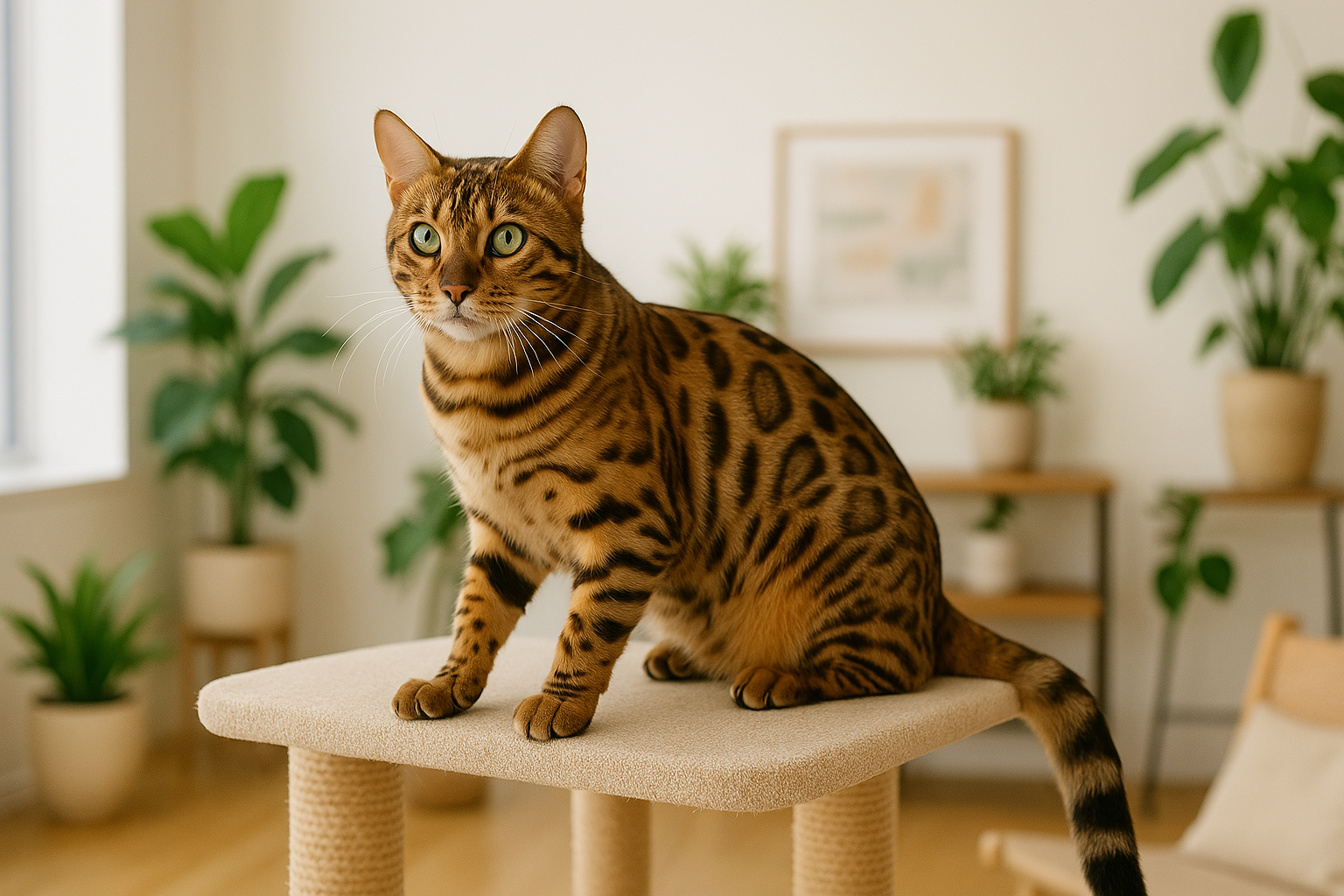With their striking spotted or marbled coats that resemble wild leopards, Bengal cats bring an exotic charm to domestic life. But beyond their stunning appearance, Bengals are high-energy, highly intelligent, and endlessly curious cats that require active engagement and proper care to thrive.
In this guide, you’ll discover how to raise a happy and well-adjusted Bengal cat — including their unique behavior, exercise needs, and how to create an enriching environment for your little adventurer.
The Wild Aesthetic – But Fully Domestic
Bengals are the result of crossing domestic cats with the Asian leopard cat — though modern Bengals are fully domesticated, usually 4+ generations removed from their wild ancestors.
They are known for:
- Exotic coat patterns (rosetted, spotted, or marbled)
- Glittered fur that sparkles in the light
- Athletic builds and strong bodies
- High intelligence and trainability
- A love for climbing, jumping, and exploring
If you want a cat that acts more like an explorer than a napper — the Bengal may be your perfect match.
Bengal Cat Personality
Bengals are:
- Energetic and highly playful
- Incredibly curious and observant
- Talkative, often using chirps or meows
- Loyal and affectionate, especially with involved owners
- Not typically lap cats — they prefer being on the move
They’re very social and do best in homes where they get daily interaction, both physical and mental.
Creating an Enriching Home
Bengals need more stimulation than the average cat. Without it, they can become destructive, anxious, or excessively vocal.
Tips for an ideal Bengal home:
- Install cat trees and climbing shelves
- Create window perches to watch birds and outdoor activity
- Offer interactive toys, puzzle feeders, and rotating toy schedules
- Provide daily play sessions (15–30 minutes at least, 2–3 times/day)
- Use clicker training or leash walking for mental challenge
Some Bengal owners even create indoor “catios” or leash-walk their Bengals like dogs — they truly love adventure.
Grooming and Coat Care
Bengals have short, dense coats that are incredibly soft and low-maintenance.
Grooming tips:
- Brush once a week (or less) to remove loose hair
- Wipe coat with a damp cloth for extra shine
- Bathe rarely — they generally stay clean on their own
- Trim nails every 2–3 weeks
- Brush teeth regularly to prevent dental disease
Many Bengals even enjoy water — some love drinking from faucets or splashing in bathtubs.
Feeding and Nutrition
Due to their active metabolism, Bengals need a high-protein, nutrient-rich diet.
Feeding advice:
- Choose premium cat food with real meat as the first ingredient
- Feed measured meals 2–3 times per day
- Use puzzle bowls or slow feeders to add mental stimulation
- Keep fresh water available at all times
- Avoid fillers and high-carb diets
Consult your vet about portion sizes based on your cat’s age, activity level, and weight.
Training and Intelligence
Bengals are one of the most trainable cat breeds:
- Use positive reinforcement (treats and toys)
- Teach commands like “sit,” “high five,” or “come”
- Try leash training with a harness for outdoor walks
- Use puzzle toys and games to prevent boredom
- Avoid punishment — Bengals respond best to redirection and structure
They also love learning tricks and can be taught to fetch, open drawers, or ring bells for treats.
Bengals and Other Pets
Bengals are social but dominant. Early socialization is key to harmony.
With other pets:
- Introduce them slowly and under supervision
- Avoid pairing with timid cats unless raised together
- Bengals often enjoy the company of dogs (especially active breeds)
- Provide escape routes and vertical spaces for cohabiting pets
Their strong prey drive means they may not mix well with small pets like hamsters or birds.
Health Considerations
Bengals are generally healthy, but potential health concerns include:
- Hypertrophic Cardiomyopathy (HCM) – common in the breed
- Progressive Retinal Atrophy (PRA) – affects vision
- Luxating patella – joint issues
- Dental disease – due to tight jaw structure
Preventative care:
- Annual vet checkups
- Regular dental hygiene
- Genetic testing from breeders if purchasing a kitten
- Watch for sudden weight loss or behavioral changes
With good care, Bengals often live 12–16 years or more.
Final Thoughts: Is a Bengal Right for You?
A Bengal could be your perfect feline companion if you:
- Love interactive, energetic pets
- Have time daily for play, training, and bonding
- Enjoy a cat that acts more like a dog
- Can offer a stimulating and enriched environment
- Want a cat that’s as intelligent as it is beautiful
Bengals bring excitement, intelligence, and a touch of the wild to everyday life. With the right home, they’ll be a loyal, fascinating, and endlessly entertaining family member.

